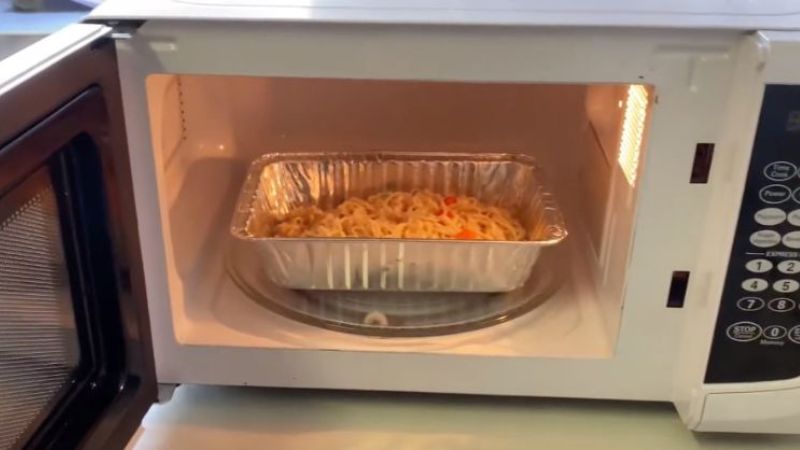Microwave ovens have revolutionized the way we cook, providing quick and convenient meal preparation. Aluminum foil, known for its heat retention properties, is a popular kitchen tool used to enhance cooking outcomes.
However, when it comes to using aluminum foil in a microwave oven, safety concerns arise. In this comprehensive guide, we will delve into the topic of whether aluminum foil can be safely used in a microwave oven and offer valuable tips to ensure its safe usage.
Table of Contents
Understanding Microwaves and Aluminum Foil
To grasp the safety implications, let’s first explore how microwaves function and the characteristics of aluminum foil. Microwave ovens generate heat by bouncing radio waves off food, causing water molecules to vibrate and produce heat energy. The microwave cavity, lined with a metal shield, prevents the escape of microwaves into other areas.
On the other hand, aluminum foil consists of tightly rolled thin sheets of aluminum, possessing low electrical conductivity and non-magnetic properties. These qualities make it suitable for various cooking applications, as it retains moisture and heat, resulting in evenly cooked food when used in a microwave oven.
Safety Concerns and Precautions
Using aluminum foil in a microwave oven requires caution to avoid potential dangers. Improper use can lead to arcing, sparks, and even fires as the radio waves interact with the foil’s surface. Manufacturers often include warnings against using metal objects inside the oven cavity or near its walls. To mitigate risks, consider the following precautions:
- Adhere to the recommended thickness specified by the manufacturer: Thicker foil sheets tend to absorb or reflect more microwaves, increasing the risk of arcing, sparks, and fires.
- Avoid folding or crumpling the foil: Folding or crumpling the foil can create areas of increased intensity and raise the chances of arcing.
- Be mindful of the shape and size of the food being cooked: Foods with sharp edges or points can amplify reflections, while larger foil pieces necessitate more heating time, resulting in heightened microwave intensity and increased reflection.
Factors Influencing Safe Usage
Several factors influence the safety of using aluminum foil in a microwave oven. Understanding these factors can help you make informed decisions and ensure safe usage. Consider the following:
Thickness:
Thicker foil sheets tend to absorb or reflect more microwaves, increasing the risk of arcing, sparks, and fires. Adhere to the recommended thickness specified by the manufacturer.
Shape and size of the food:
Foods with sharp edges or points can amplify reflections, increasing the likelihood of arcing. Additionally, larger foil pieces may require more heating time, leading to heightened microwave intensity and increased reflection.
Frequency and distribution of microwaves:
Higher frequencies produce stronger waves that can induce more reflections. Uneven distributions of microwaves within the oven cavity can result in hotspots, elevating the risk of arcing and sparks.
Best Practices and Alternatives
To ensure the safe usage of aluminum foil in a microwave oven, it is crucial to follow best practices and consider alternatives. Implement the following best practices:
- Limit usage to no more than two layers of foil: Using excessive layers can lead to increased reflection and potential arcing.
- Avoid folding or crumpling the foil: Folding or crumpling can create areas of increased intensity, raising the chances of arcing, sparks, and fire.
- Steer clear of sharp points or edges: Avoid using aluminum foil with sharp edges or points to minimize reflection and arcing risks.
Alternatively, consider the following alternatives to aluminum foil:
Microwave-safe containers and covers:
Use microwave-safe containers and covers designed to withstand the heat and ensure safe cooking.
Microwave-safe plastic wraps:
Specific types of plastic wraps are designed for microwave use and can be used as alternatives to aluminum foil.
Uses and Benefits
The application of aluminum foil in a microwave oven offers several benefits, such as retaining moisture, heat, and flavor while ensuring even cooking. It is commonly employed for reheating leftovers like pizza, casseroles, lasagna, and other dishes that require uniform heating. Moreover, aluminum foil can be utilized to create makeshift baking dishes or steamers within the microwave by placing a layer over the food.
Conclusion
Using aluminum foil in a microwave oven can yield various benefits, including heat and moisture retention and even cooking. However, it is vital to follow manufacturer warnings and implement necessary safety precautions to minimize the risk of arcing, sparks, and fires.
Alternatively, consider utilizing microwave-safe containers, covers, and specific plastic wraps as alternatives to aluminum foil. By incorporating these safety tips and precautions, you can confidently and safely use aluminum foil in your microwave oven.
Frequently Asked Questions
Q: Is it safe to use aluminum foil in a microwave oven?
Generally, it is safe to use aluminum foil in a microwave oven. However, adherence to safety precautions is crucial. Follow best practices such as using a maximum of two layers of foil, avoiding folding or crumpling, and steering clear of sharp points or edges.
Q: What alternatives can I use instead of aluminum foil in a microwave oven?
Several alternatives exist, including microwave-safe containers, covers, and specific types of microwave-safe plastic wraps. These options provide better protection against overheating and arcing compared to aluminum foil.
